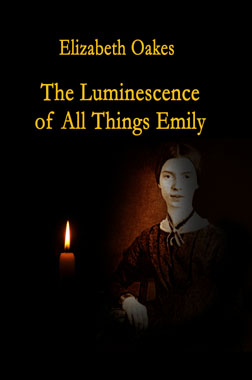Book Review
The Luminescence of All Things Emily by Elizabeth Oakes, Wind Publications, 2009. $15
Reviewed by Moira Richards
For me, a South African, Emily Dickinson is not the well-known, well-loved poet and personage that she is to her compatriots so I welcomed the chance to learn, through poems, a little more about the woman behind the famous name.
The short foreword to Elizabeth Oakes’ collection contextualises Emily and the members of her immediate family and gives some broadly brush-stroked idea of the dynamics of the relationships. A dozen or so pages at the end of the book note bits of detail and background history to specific poems in the collection. Many of the poems play too, with words and lines from Emily Dickinson’s work and these instances are also explicated in the end notes.
The first few, grouped in a section entitled simply, Emily, evoke the delicate, seemingly hesitant yet actually very sure-penned young woman on the cover of the book with short lines, sometimes disconcerting line breaks, rich imagery:
…she
awoke to a sky
that was pink
without treacle, to
the open mouth
of a rose dawn.As Emily Slept
…Emily now starts
her writing for the day, closes
the door to the stairs that squeak
even from her quiet feet.
The Light over Amherst
This sense of self-effacing yet definite (determined?) quietude about Emily Dickinson appears again in a later poem narrated by Dickinson’s sister, Lavinia (Vinny) by way of A Locket of Remembrances after Emily’s death. Again, Owens uses odd-yet-sure line breaks, the evidence of control beneath the seeming effacement:
It’s the smallest things
that linger about my sister:her hand patting a loaf
of bread, the sheen
of butter on her palm,the quiet stirring of her spoon
and the click it made as she
lay it carefully on the saucer,
no drop to fall on the lace
tablecloth or her white dress.
Her placement of cupand saucer just so, the quick
lift of her lip as she drank.Somehow the house was
quieter when she was here.
Austin Dickinson and Mabel Loomis Todd fill the largest section of The Luminescence of All Things Emily and here we’re told that When Austen and Mabel Made Love at the Homestead
the orgasms quick, the panting soon subsiding
into normal breaths, Emily wrote, her hand
dipping in the ink, moving like a snake
in the grass, lapping up the miles.
How arresting, that phrase ‘in the grass’ enjambed onto the snake.
The lusty love affair commands its pages in long lines of runaway too, perhaps, poetry. We learn that the couch upon which the pair consummated their relationship is still on display in the dining room of Emily’s house, and that The Day before Austin and Mabel Began Their Affair
…Emily poured a glass of her currant
wine from the rose decanter. It’s still here
too in the dining room, refracting light
onto the wall. It gleamed to Austin like
the memory of a heart he once thought he had.
We learn, feel, through Elizabeth Oakes’ erotic images, the absolute surrender of Austin to Mabel, the heat of their passion:
He seeped into her like water
into inlets. It was like gravity.Solids and Fluids
Each time Austin leaves Mabel, his limbs are
dross after a rising of spirit like smoke.
…
…he could feel her in the dusk
of evening, she him in the wind that blew her skirt.Leaving Mabel
Susan Dickinson, Emily’s parents, her sister, the household employees all come to life in this Luminescence of all things Emily. Lavina, Vinnie, remembers her famous, famously ‘different’ sister with words by which Emily herself is probably best remembered:
I’ll tell you how the sun
rose, my sister wrote, a ribbon
at a time. She was writing this
while I was reading to mother,
helping Maggie churn butter,
on my way to Cutler’s with a
request for coconut, graham
flour, sweet potatoes, sugar,
kerosene, ginger snaps,
molasses—whatever the
household needed.It was Em’s job to think,
however, and Austin’s to
make the money after father
died. Austin and I became
Emily’s parents, even in
a way her servants. How this
happened I don’t know, but
it wasn’t just duty. She is still
in the front parlour of my heart.(Vinnie Outlives Them All)
That is perhaps my favourite of the techniques Elizabeth Oakes employs in these drawings of Emily Dickinson’s life—her ribboning of bits of the earlier poet’s words and imagery into her own poetic (re)creation of that poet.
One example more. The last section is entitled, West Cemetery, Amherst, Massachusetts, and the title is accompanied by the following quote from Dickinson’s Poem 883…
The Poets light but Lamps—
Themselves—go out—
Oakes’ poem, The Death Watch, on the following page picks up on Emily’s thought about poets using themselves, extinguishing themselves, as part of the process of the creation of their art. It reads in part;
No one knew
the number of poems
secreted in a drawer,
in Maggie’s trunk,
written on scraps
of paper, on envelopes,
on the back of a
chocolate bar wrapper.Spring saw
her final days.In the just thawed
soil of Amherst,
Emily burst
into bloom.
Moira Richards lives in South Africa and hangs out here:http://www.darlingtonrichards.com and here: http://www.redroom.com/author/moira-richards.


